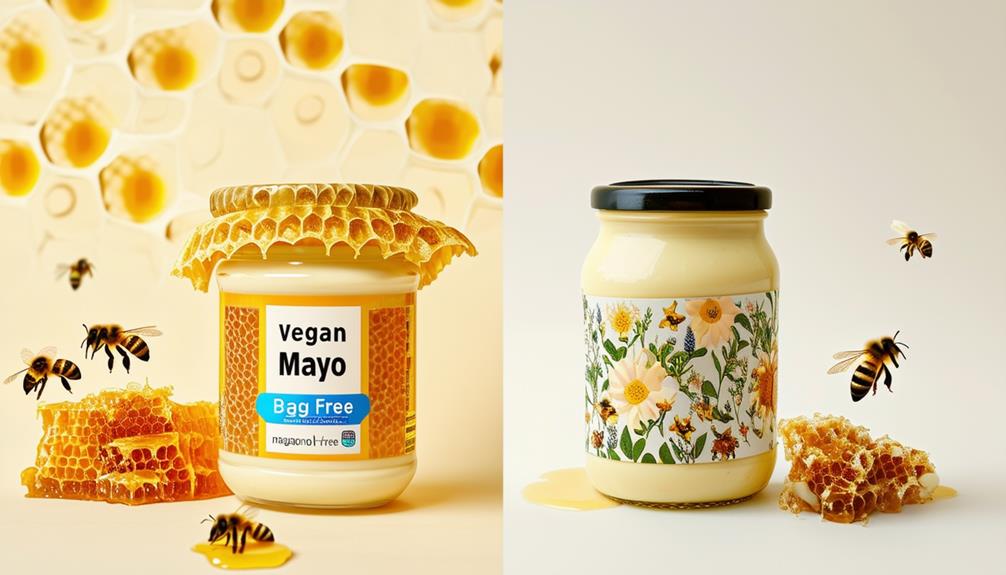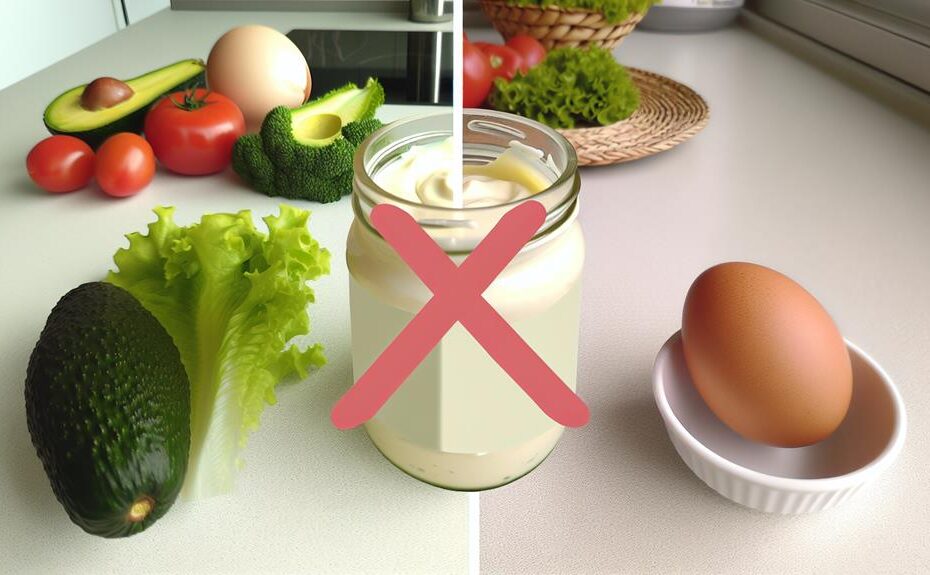You're probably wondering: is mayo vegetarian? The answer's not as central as you might think. Traditional mayonnaise typically contains eggs, making it off-limits for vegetarians. But, you might be surprised to learn that vegan mayo alternatives are popping up everywhere, using clever substitutes like aquafaba to replicate the creamy texture. As you navigate the condiment aisle, it's important to scrutinize labels for hidden animal-derived ingredients. So, what's the verdict on mayo's vegetarian status? There's more to the story, and it's about to get interesting.
Vegan Mayo's Humble Origins
In the 1970s, you stumbled upon a game-changing alternative to traditional mayonnaise at Follow Your Heart Cafe, where the founders were busy crafting Vegenaise, the pioneering egg-free mayo that would soon become a staple in plant-based cuisine.
This creative condiment was specifically created for their signature sandwich, and it didn't take long for it to gain popularity. Vegenaise, the brainchild of Follow Your Heart Cafe's founders, revolutionized the world of vegan cuisine by offering an eggless mayo that was both delicious and cruelty-free.
As the trailblazer of its kind, Vegenaise paved the way for a new generation of vegan mayos, earning its spot as a pioneer in the plant-based industry. This vegan mayo's humble origins can be traced back to the 1970s when the founders of Follow Your Heart Cafe dared to challenge traditional mayonnaise with their eggless alternative.
Today, Vegenaise remains synonymous with egg-free mayo, a demonstration of the power of innovation and creativity in the world of plant-based cuisine.
Free From Animal By-Products
As you delve into the world of vegetarian mayo, you're probably curious about what makes it 'free from animal by-products.'
You'll be thrilled to learn that many vegan mayo options are rich in aquafaba protein, which gives them a distinctive flavor profile.
Let's take a closer look at the flavors of vegan mayo and how they're made possible by this inventive ingredient.
Flavors of Vegan Mayo
As you navigate the world of vegan mayo, you'll encounter a variety of flavors that will enhance your dishes to the next level. From classic to adventurous, these flavors are crafted to tantalize your taste buds without compromising your vegetarian principles.
Here are some exciting options to try:
- Garlic and Herb Flavor
- Smoky Chipotle Flavor
- Lemon Dill Flavor
Garlic and Herb Flavor
You can indulge in the savory taste of Garlic and Herb Flavor vegan mayo, which is specifically crafted to exclude animal by-products, ensuring a guilt-free experience for vegetarians.
This vegan mayo variant offers a flavorful twist with the incorporation of garlic and herbs, providing a tasty alternative to traditional mayo without compromising on taste.
Smoky Chipotle Flavor
Smoky chipotle flavor in vegan mayo ignites your taste buds with a spicy and savory twist that's free from animal by-products, aligning perfectly with vegetarian diets. This flavor adds a unique and bold taste to sandwiches, salads, and dips. You can enjoy a plant-based alternative with a kick!
| Flavor Profile | Taste | Usage |
|---|---|---|
| Smoky Chipotle | Spicy, Savory | Sandwiches, Salads, Dips |
| Garlic and Herb | Aromatic, Zesty | Veggie Burgers, Grilled Veggies |
| Lemon Dill | Bright, Invigorating | Salads, Seafood, Veggies |
| Roasted Garlic | Rich, Earthy | Soups, Stews, Mashed Potatoes |
| Classic Mayo | Creamy, Neutral | Sandwiches, Salads, Dipping Sauce |
Lemon Dill Flavor
In vegan mayo, the Lemon Dill flavor stands out with its stimulating and rejuvenating twist, combining the vibrancy of lemon with the subtle notes of dill.
You'll love using this plant-based, vegan mayo flavor in sandwiches, salads, or as a dip.
Free from animal by-products, it's perfect for vegetarians and vegans alike, offering an invigorating twist on traditional mayonnaise.
Rich in Aquafaba Protein
As you delve into the world of vegetarian mayo, you'll find that aquafaba, a protein-rich liquid from cooked chickpeas, plays an essential role. This amazing ingredient is what makes vegetarian mayo possible, and it's packed with benefits.
Let's take a closer look at the key components that make aquafaba-based mayo a game-changer:
- Chickpea Brine Liquid Protein
- Apple Cider Vinegar Powder
- Tapioca Starch Powder
Chickpea Brine Liquid Protein
You'll find that chickpea brine, also known as aquafaba, is a versatile ingredient rich in plant-based protein, making it an excellent substitute for eggs in a diverse range of recipes.
As a vegan-friendly egg substitute, aquafaba is perfect for making vegan mayo, meringues, and baked goods. Its protein-rich properties create light and fluffy textures, making it a popular choice for vegan cooking.
Apple Cider Vinegar Powder
Incorporating apple cider vinegar powder into your recipes can boost their flavor and nutritional profiles, thanks to its richness in aquafaba protein.
As a vegetarian-friendly ingredient, it's perfect for adding a tangy twist to your mayonnaise or other dishes.
Made from dehydrated apple cider vinegar, this powder is free from animal by-products, making it a great supplement to your vegetarian cooking repertoire.
Tapioca Starch Powder
Tapioca starch powder, a vegan-friendly staple, improves the texture and stability of your mayonnaise by replacing eggs and animal-derived thickeners.
As a rich source of aquafaba protein, it's a popular ingredient in vegan mayo recipes. This plant-based thickener helps create a smooth, creamy vegan mayo, making it a great inclusion to your plant-based mayonnaise.
Honey in Some Recipes

Now that you've investigated how some mayo recipes exclude animal by-products, let's analyze another key ingredient that might affect the vegetarian status of mayo: honey.
You'll find that honey is sometimes added to mayo for sweetness and flavor, which can be a concern for strict vegetarians who avoid animal-derived products.
Egg Yolks in Regular Mayo
As you investigate the world of mayonnaise, you'll uncover that traditional recipes often include egg yolks, which can be a deal-breaker for vegetarians. But that's not all – some recipes may also include honey, which sparks debate among vegetarians.
Let's take a closer look at the ingredients that make traditional mayo non-vegetarian:
- Egg Yolks in Traditional Mayo
- Gelatin
- Lactic Acid Casein
Egg Yolks in Traditional Mayo
Here's the output:
Traditional mayonnaise recipes typically rely on egg yolks, which serve as the primary emulsifying agent, making them an indispensable component in the preparation of regular mayo. As you investigate traditional mayo, you'll find egg yolks play a vital role. Here's a breakdown of traditional mayo's key components:
| Ingredient | Function | Importance |
|---|---|---|
| Egg Yolks | Emulsifying Factor | High |
| Oil | Thickening Agent | Medium |
| Acid (Vinegar/Lemon) | Flavor Enhancer | Low |
Note: The table is a simple breakdown of traditional mayo's key components, highlighting the importance of egg yolks.
Gelatin
You might be surprised to learn that gelatin, a common thickening agent, isn't vegetarian due to its animal-derived origins. As a vegetarian, you'll want to avoid gelatin, which is often used in desserts and candies.
As for mayo, you'll also want to steer clear of traditional egg-based mayo and opt for vegan alternatives instead.
Lactic Acid Casein
When you're scanning the ingredient list of your favorite mayo, you might be surprised to find lactic acid casein, a milk derivative, in some vegetarian mayo recipes. This raises questions about the definition of vegetarianism. Here's a breakdown of mayo ingredients:
| Ingredient | Vegetarian? |
|---|---|
| Egg Yolks | No |
| Lactic Acid Casein | No |
| Honey | Yes |
| Plant-Based Substitutes | Yes |
| Regular Mayo | No |
Sodium Benzoate in Some
As you investigate the ingredients in your mayonnaise, you might come across sodium benzoate, a common preservative used to prevent the growth of yeast, mold, and bacteria.
But did you know that there are other preservatives used in mayo as well? Let's take a closer look at some of these alternatives:
- Potassium Sorbate Preservative
- Xanthan Gum Preservative
- Calcium Disodium EDTA
Potassium Sorbate Preservative
Mayo manufacturers often turn to potassium sorbate, a naturally derived preservative, to extend the shelf life of their products.
As a vegetarian, you should know that potassium sorbate is a safe bet, unlike honey which isn't vegetarian due to its bee origin.
Check labels for potassium sorbate, a reliable preservative that aligns with your dietary preferences.
Xanthan Gum Preservative
You'll often find xanthan gum, a versatile preservative, in vegetarian mayo products, where it improves stability and texture, but beware of some recipes that might include honey or sodium benzoate.
As a thickening agent and emulsifier, xanthan gum is a common additive in vegetarian mayo, but it's crucial to check labels for these ingredients to confirm they align with your dietary preferences.
Calcium Disodium EDTA
When scanning the ingredients list, you're likely to come across Calcium Disodium EDTA, a preservative that plays a crucial role in maintaining the quality and safety of your mayonnaise.
This preservative helps prevent discoloration and maintains flavor.
Here's a breakdown of Calcium Disodium EDTA:
| Purpose | Effect |
|---|---|
| Prevent discoloration | Maintains mayonnaise color |
| Maintain flavor | Preserves taste |
| Inhibit bacteria growth | Secures food safety |
| Extend shelf life | Increases product longevity |
| Improve general quality | Maintains mayonnaise quality |
Mono and Diglycerides
Beyond Calcium Disodium EDTA, another key component in mayonnaise is Mono and Diglycerides, emulsifiers that can originate from plant or animal sources, affecting the vegetarian status of your condiment.
Some mayos may also contain honey as a sweetener, making them non-vegetarian, or sodium benzoate as a preservative, which may not align with your dietary preferences.
Aquafaba Power in Mayo
Tap into the aquafaba power in mayo by harnessing its unique properties to create a vegan alternative that's just as creamy and rich as its traditional counterpart.
You might be wondering how this magic happens. It's all about the composition of aquafaba, the liquid from cooked chickpeas. Its protein and carbohydrate content help create the creamy texture and binding properties crucial in mayo.
The viscous nature of aquafaba makes it an ideal ingredient for vegan mayo, offering a plant-based alternative to eggs. By using aquafaba, you can create a vegan mayo that's nearly identical to traditional mayo in terms of taste and texture.
This showcases the versatility of aquafaba beyond traditional culinary uses, highlighting its potential in vegan cooking. With aquafaba, you can enjoy a vegan mayo that's rich, creamy, and free from animal products.
Conclusion
You've learned that mayo can be vegetarian, depending on the ingredients used. Traditional mayo contains eggs, but vegan mayo substitutes eggs with plant-based ingredients like aquafaba.
When shopping, check labels for non-vegetarian additives like gelatin or animal-derived emulsifiers.
By choosing vegan or vegetarian mayo options, you can enjoy this creamy condiment while aligning with your dietary preferences.
With a little awareness, you can savor the flavor of mayo, guilt-free and vegetarian-friendly.
